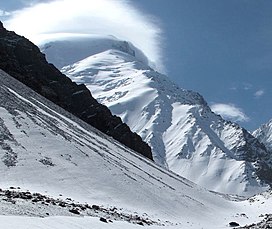
Perched in the majestic Hindu Kush range, Noshaq stands as Afghanistan’s highest peak, a towering sentinel at an elevation of 7,492 meters (24,580 feet) above sea level. This formidable mountain, straddling the border between Afghanistan and Pakistan, is more than just a geographical landmark; it is a beacon of natural beauty, challenging terrain, and intriguing nomenclature. “Noshaq,” often interpreted as “nine horns,” reflects not only the physical grandeur of this icy giant but also the rich tapestry of cultural and linguistic heritage surrounding it.
The name Noshaq, translating to “nine horns,” is emblematic of the mountain’s distinct features. It conjures images of the rugged, horn-like peaks that define its silhouette against the sky. This nomenclature is steeped in the tradition of using descriptive language to capture the essence of a landscape, a common practice in the diverse linguistic tapestry of the Hindu Kush region. The interpretation of Noshaq as “nine horns” offers a glimpse into how local populations have historically related to the natural world around them, seeing in its contours stories and symbols.
Noshaq’s prominence extends beyond its physical height; it is a mountain of many firsts. It was the highest peak in Afghanistan to be successfully summited, with the first ascent recorded in 1960 by a Japanese expedition. This achievement marked the beginning of Noshaq’s recognition on the global stage as a mountaineering destination. Moreover, Noshaq has since become a symbol of aspiration for climbers, both local and international, seeking to conquer the heights of the Hindu Kush.
The slopes and valleys surrounding Noshaq are a testament to the resilience of life in extreme conditions. This region is a sanctuary for a range of flora and fauna, some of which are endemic to the area. The biodiversity of the Noshaq area underscores the ecological significance of high-mountain environments and the importance of their conservation.
Noshaq and its surrounding landscapes face environmental and human-induced challenges. Climate change poses a significant threat, with glacial melt impacting water sources and local ecosystems. Additionally, the region’s accessibility has made it vulnerable to overuse and pollution, threatening the pristine nature of this wilderness area. Efforts to conserve Noshaq’s environment are crucial in preserving its unique biodiversity and the natural heritage it represents.
In recent years, Noshaq has emerged as a symbol of peace and unity. Expeditions to its summit have included climbers from diverse backgrounds, including Afghan nationals, aiming to foster a sense of national pride and cohesiveness. These initiatives highlight the mountain’s role in promoting not only environmental awareness but also social cohesion and peace-building in a region marred by conflict.
Noshaq, the “nine horns,” stands as a monument to nature’s awe-inspiring beauty and the human spirit’s resilience. Its name, evoking images of towering, horn-like peaks, captures the essence of this majestic mountain. As the highest point in Afghanistan, Noshaq is not only a challenge for mountaineers but also a beacon of biodiversity, a subject for conservation efforts, and a symbol of peace. It remains a testament to the enduring connection between humans and the natural world, inspiring those who gaze upon its peaks to strive for harmony within themselves and with the planet.